iPads aren’t compatible with site gloves, contracts haven’t kept up with a digital age and we’d rather die than modernise – some of the reasons why paper is still going strong, according to participants in BIM+’s latest round table with Bluebeam. Denise Chevin chaired the debate. Photography by Julie Kim.
How will construction project teams collaborate in the future and what kind of techniques will they use to minimise risk? With increasingly complex projects to deliver and extensive supply chains to manage, information management and data sharing is crucial to all construction companies. Can the digital sharing of information help foster improved performance and what are the barriers to making it happen? And why do so few seem to have mastered it?
These were some of the talking points at a round table convened at Construction Manager’s offices in London, in association with Bluebeam, on the theme of better collaboration, now and in the future.
Denise Chevin: Given there is so much evidence and efficiency to be gained using digital systems why do people still feel wedded to paper? Is it a lack of trust, lack of investment? Are people scared of the unknown?
Vicki Holmes: It’s a mixture of all of the above. The tools we are investing in to deliver digital construction are of an unknown standard. We get hardware and software but end up with people on site using iPads which aren’t compatible with their site gloves, so you have to learn as you go as you’ve already invested in it.
Secondly, it’s humans who are using it and it’s asking humans to change their mindset to something awkward. If you have any negative feedback from that experience you go back to what you know. Paper doesn’t clunk.
Neil Donaghy: Having rolled out tablet technology, it exposed how scared individuals were to press the go button as the data went out to the world and they couldn’t get it back. They couldn’t relate input to output. Reporting formats don’t brand themselves to look like a corporate document so people will go back to completing paper forms.
May Winfield: A lot of it is about mindset. Construction is not innovative. Contracts in law are very reactive – only when something has happened or someone has lost a lot of money do you see change. Contracts insist on BIM Level 2 but no one has lost a lot of money yet. Banks and lawyers have paper contracts.
They don’t understand the changes and technology in the way we work so they go for the safest option. No lawyer will put in a clause that says you will only have electronic deliverables. They won’t say you don’t need paper copies any more. You need a test case. It is changing but it’s a legal mindset of mitigation.

The panellists
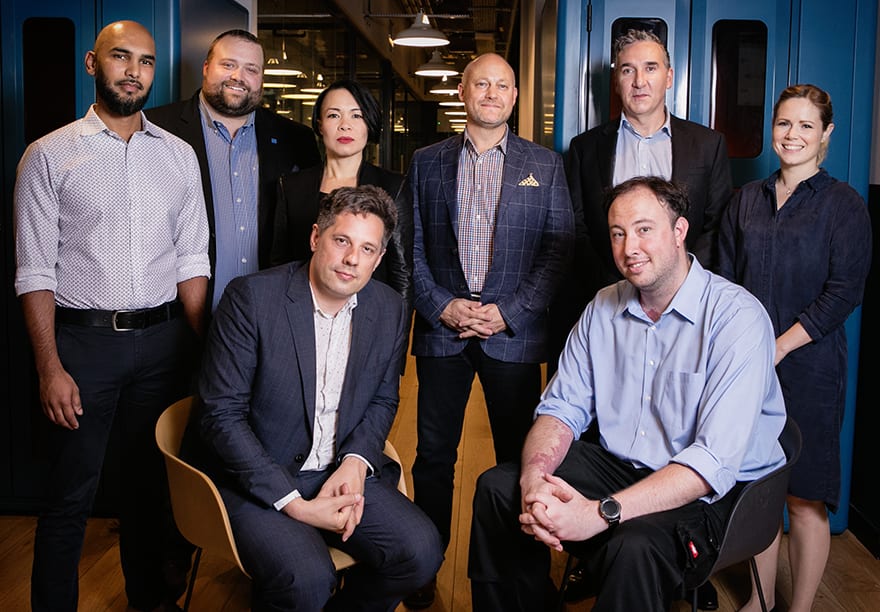
Standing l-r: Javed Edahtally, head of BIM and management, Metropolitan Police; Todd Wynne, VP of business development and partnerships, Bluebeam; May Winfield, senior construction lawyer; James Chambers, UK country manager, Bluebeam; Neil Donaghy, head of BIM and digital engineering, Skanska; Vicki Holmes, learning partner, Multiplex.
Seated l-r: Thomas Lindner, director, Holden River Consulting; Gibbs Burke, senior facade construction manager, Ballymore.
Not pictured: Mike Turpin, director and digital BIM consultant, Innovating Futures.

Thomas Lindner: There are three issues. When you work in construction you have a limbic system that tells you are tough and you work hard. The second is that you’re single-minded – that thick-headedness that there isn’t another way to do it. The last one is this belief that you must make no money. We have paper-thin profit margins and the problem is that we are proud of that. Paper is the single-mindedness. We’ve been told to modernise or die but we’d rather die.
Mike Turpin: We need to see the value of it, but the industry doesn’t see a tangible benefit.
VH: People are still being paid per drawing which is against the ethos of digital construction.
Todd Wynne: Paper is static. If that’s printed it’s not changing, but it will need to change as it’s already obsolete.
Javed Edahtally: But there is a generation that is born to digital, so we are moving.
DC: What’s your level of going digital?
VH: As an organisation we are using digital managers as champions for bringing in new technology. It has forced a mind shift. Along with that we have had to figure out how we capture every person at every level. Everyone becomes the champion of their own little win. We are moving in the right direction.
ND: We started using technology in 2008/9. Had some good wins in how people interfaced with devices. We still have a journey to go and we could do things like ban use of printers during certain times of day. We could ban Excel. We could go to databases directly.
TL: After the mindset the next issue is lack of leadership. If you have a facility to print, people will use it – it’s their comfort blanket. If you provide an alternative, they will use it.
MT: It’s finding the right balance in the right place. There are certain situations where paper is right but other times a tablet or laptop is right.
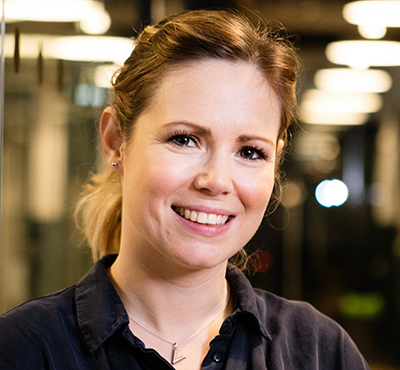
Vicki Holmes, Multiplex: There’s a huge element of finding your “why” to it.
JE: We are trying to drive it. We are not specifying paper outputs: we are asking for digital models and we’ve a had a bit of pushback with connection to 2D layouts. All information from the supply chain should migrate over to digital without need for paper whatsoever. We can review all drawings digitally. That’s our approach – we do want to go paperless, we see no need for paper at all.
DC: Is there a legal issue?
JE: Yes, that’s come up especially with BIM Level 2 contracts. People want to hand over paper to say “that’s what we signed up to” – even a PDF. But it’s a point in time, whereas a digital model is a live moving beast. So, there is an issue too about intellectual property – specific design that people have created: they feel it belongs to them. We have had a lot of resistance but there aren’t many contractors working truly in BIM 2.
Gibbs Burke: Unfortunately, it’s an uphill battle with our supply chain. They like paper as it’s a physical thing they can hand to you. We have to set the bar – so we have to refuse to accept it. I insist on digital. You have to pull the plug on the printer, take away their drawings. I had a guy who walked up several storeys three to four times and back because he took the wrong drawings from his desk. I had them on the iPad right there.
DC: So, we need people to understand that digital leads to efficiencies?
MW: The fundamental starting point is contracts, but also clients’ requirements. Lots say they’d like to do a bit of digital but they don’t know what, they just want to save some money. Lawyers don’t understand BIM either. So the client turns to the supply chain and asks for a vague thing rather than saying: I don’t want any paper. Once you force people into a different way of working, they will see it is more efficient but until you make people do it a different way there is a fear.
VH: There’s a huge element of finding your “why” to it. At Multiplex we were pushing BIM for a while as everyone else was but we didn’t know why. But then we reassessed and said: let’s ignore the client and subcontractor and ask what does BIM do for us? What does digital construction give us in terms of benefits?
When we listed those, we came up with a minimum standard for modelling and asset data. If the client doesn’t want operational requirements, we can guarantee that in five years’ time if they’ve had five Multiplex projects the data sets will be the same. So when they realise they do want that data they can have it.
ND: There’s a big risk that consultants feed clients a pile of “not good information”. Some of the specs Skanska have gone through have caused problems. They are rubbish.
MT: A lot are so complicated – 100 pages long, duplicates, trying to make it look good.
MW: You see cut-and-paste jobs in tenders. Half is not relevant.
GB: Wouldn’t knowing where that cut and paste has come from make it safer? Do they take the digital document and scan it back in so no-one takes liability? You should be able to see where people have marked it up.
MW: I think it’s more that some consultants try to be comprehensive so have a document asking for everything with different versions of it. Employers don’t know because they have different employers. So we ask: do you need that?
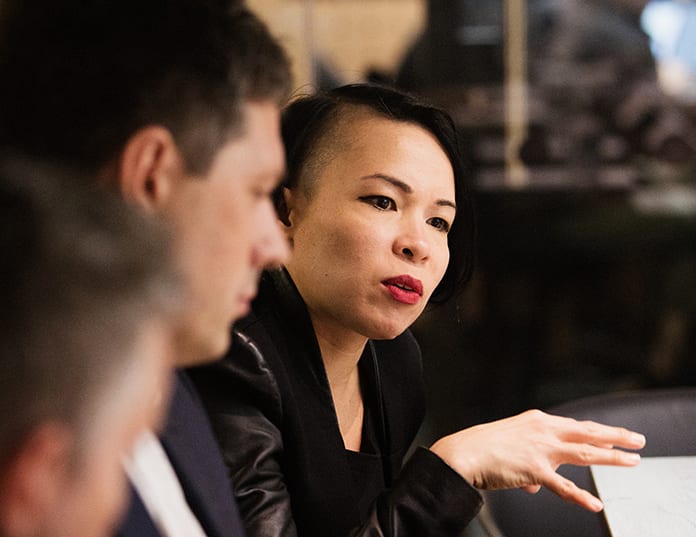
May Winfield: “It’s more time and cost efficient for disputes if you use digital”
VH: I’ve been on both sides. I was a BIM consultant. There were times when you would speak to the construction team not the FM team, so we would ask operational requirements and were told “We don’t have one, can you give us everything?” We’d start the job and six months later get introduced to the FM team. It’s a disconnect. If a banking company is building a site they will have an FM team somewhere but the people constructing that site aren’t connected to them.
James Chambers: So many people are reliant on all of this but it’s so fragmented. Is there a way forward?
JE: Consultants and contractors all point and blame at each other.
GB: The reason why we like paper so much is the anonymity. If everyone marks it up no one can tell but as soon as you have a digital file you can see who authored what. You can pinpoint who wrote it if it goes wrong.
DC: Are there tangible benefits?
TL: It’s about using tools to minimise risk. As trainee carpenter the only way to reduce risk of hitting my thumb with a hammer was to have competence. The same applies. If you know what you’re doing the risk is not going away but it is reduced because you’re competent. If the person at the front isn’t competent to put the information in, that’s as bad as the person receiving the data and not knowing how to interpret it. If there’s no trust in the system people go back to what they know.
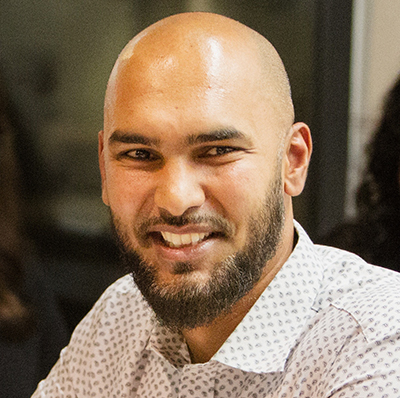
Javed Edahtally: “With digital classifications it’s helping to minimise risk around the consistency of information we are getting back”
MW: It goes back to the contract. The reason people have disputes is when something goes wrong everyone points fingers then pulls out the contract to see where risk is allocated. Then people are happier to take it. The issue goes away a lot faster or it doesn’t become an issue in the first place. It’s more time and cost efficient for disputes if you use digital.
ND: Continual design changes cause inefficiencies as the client doesn’t know what they want and keeps changing while work is under way. We should have the same system as in Japan where you can’t start building until the design is signed off.
VH: We found projects that were unbuildable once you analysed in 3D. We had tenders for concrete come back all with different quantities and costs. We did a take-off in an hour from the model and asked them to resubmit. Then you’re picking the subcontractor who is the strongest not the cheapest.
JE: With digital classifications it’s helping to minimise risk around the consistency of information we are getting back. The other thing is we have created an asset information requirement at each design stage and who that will be delivered to. It tells everyone what to deliver and reduces the risk for us as everyone is aware contractually what they need to do.
DC: Is digital promoting flexibility of working, is that helping?
JE: I’m from a design engineer background where you have engineers from all over the world working on one particular part who can link in real time and collaborate. That’s immensely useful for delivering design and moving forward for construction.
MT: People are afraid of people working from home as they don’t know what they’re producing unless they are sat there from 9-5. The attitude seems to be unless someone sends me one drawing a day how do I know what they’re doing?
DC: Software sharing – is there still reluctance to use it or is that bound up in that they want the comfort of paper?
JC: Technology isn’t going away, and the complexity of projects isn’t going away either – it will get to the point that you can’t build something with traditional philosophies.
MT: Change seems slow but it’s actually fast when you look back over the past six years.
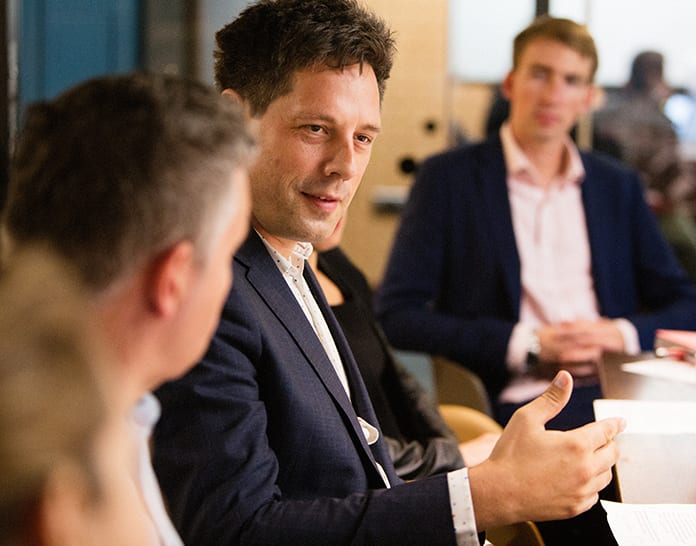
Thomas Lindner: “If the person at the front isn’t competent to put the information in, that’s as bad as the person receiving the data and not knowing how to interpret it”
TW: I keep hearing that we need to change people but we can’t change people. We are the product of our environment, so what I would challenge is changing the environment around your people and they will change.
In my past I introduced a firm to iPads. We didn’t change the people, we didn’t take away their printers and paper, we focused on surrounding them in their environment with easier systems. We printed isometrics on 30×40 paper and hung them in the trailer. In the meeting they would stand up and point to the model on paper. I told him he was doing BIM.
Focus on the technology that allows that evolution. That’s what we need to do in the industry, change the environment not the people. Let them make the change themselves when they see it’s easier.
VH: But those decisions come from senior management. So we still have to change those people.
TW: Start with micro changes at the bottom. When I bought a drone it was a toy but we saved $450,000 on one project with that drone. Look for your champions and early adopters. It’s amazing how the virus spreads. Focus on equipping them with new tools then they will choose that change.
We wrote in contracts that people use iPads and didn’t have much success but had more success when we hosted training on how to use them. I persuaded a drywaller in Texas to buy an iPad at personal cost. I saw him three years later and his entire company was using them.
It’s about technical literacy; for some it’s the first computer they’ve touched and spinning a BIM model is another level up, so make it simpler and democratise.















